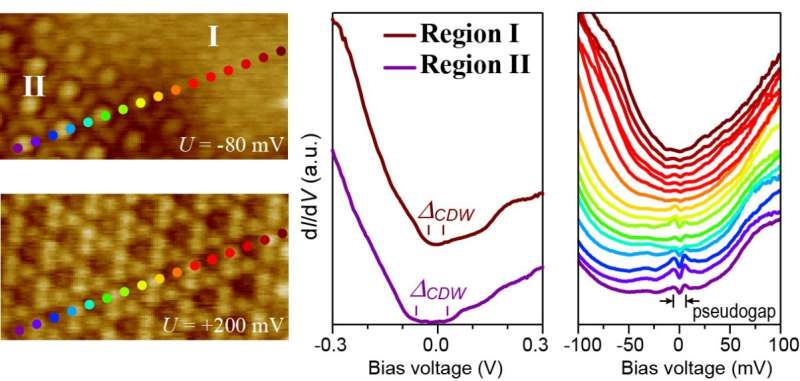Charge density wave inhomogeneity and pseudogap in 1T-TiSe2

1T-TiSe2 has been widely studied in the past few decades as one of the typical charge density wave (CDW) materials. Recently, superconductivity was realized in this system through Cu intercalation, pressure or electric gating, forming a dome-shaped superconductivity phase diagram. Owing to this resemblance to high -Tc cuprates, much attention has been paid to 1T-TiSe2 to understand the superconducting mechanism and its interplay with CDW. However, it is still under debate whether CDW competes with superconductivity or not. Via tuning the dopant level, 1T-TiSe2 system can undergo the transition from CDW to superconductivity, and thus provides an ideal platform to study the relationship between these two states.
Recently, Shao-Chun Li's group in collaboration with Jian-Xin Li's group at Nanjing University, reported the dopant-induced CDW inhomogeneity and the pseudogap state in the lightly doped 1T-TiSe2 by using scanning tunneling microscopy (STM)/spectroscopy (STS). The CDW inhomogeneity gives rise to the local reduced CDW gap, but still with the 2×2 CDW modulation. Such inhomogeneity explained naturally the previous contradicting results between the transport and XRD measurements on CuxTiSe2, which exhibited that the CDW is suppressed in transport study while CDW modulation can be still detected in the superconducting region. Furthermore, they found a new gap, which is smaller than the CDW gap and its opening temperature is higher than the superconducting transition temperature Tc, similar to the pseudogap observed in high-Tc cuprates. Upon doping electrons to the 1T-TiSe2 surface, the pseudogap evolves into a gap with coherence peaks, indicating that it is a precursor to the superconducting gap.
This study shows that the CDW state in 1T-TiSe2 doesnot compete with the superconducting state. The discovery of pseudogap indicates that the superconducting transition in 1T-TiSe2 shares some similarities to that in high Tc cuprates. Even though the formation mechanism is still not clear, the pseudogap becomes prominent upon doping electrons, and finally evolves in to coherence peaked gap. This study provides insight on the understanding of superconducting mechanism, and the interplay between superconductivity and CDW in 1T-TiSe2.
More information: Kai-Wen Zhang et al, Unveiling the charge density wave inhomogeneity and pseudogap state in 1 T -TiSe 2, Science Bulletin (2018). DOI: 10.1016/j.scib.2018.02.018
Provided by Science China Press



















